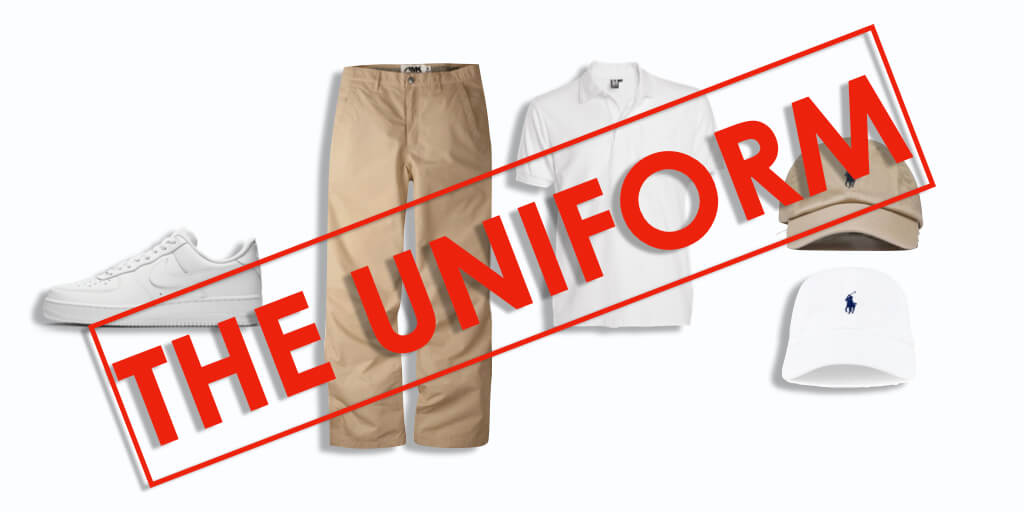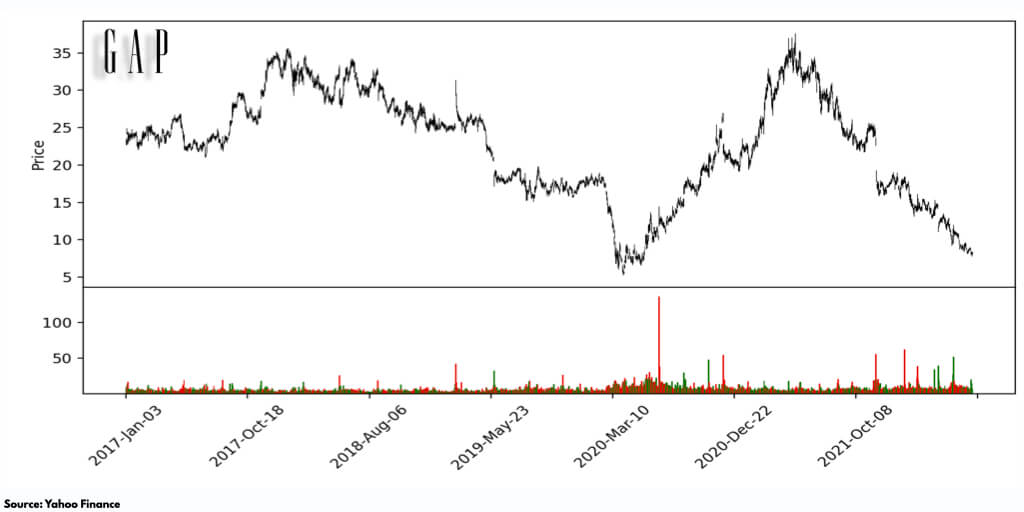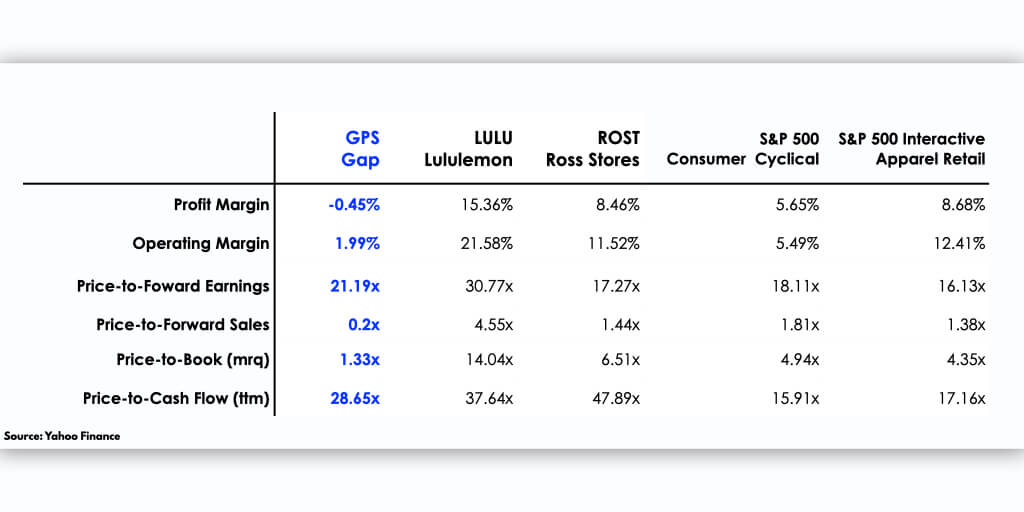The Issue With Gap
Why Gap Ceos Can't Turn The Company Around

- Gap's lack of identity has cost another CEO thier job
- Gap's stock price has declined 67% since 2019, and has forced CEO Sonia Syngal to resign.
- Syngal's resignation signals to the market that the Gap and Kanye West collaboration wasn't enough to turn the company around.
- There are several solutions Gap's management could employ to turn the company around.
Of all the five New York boroughs, Queens is the best dressed. Not hate, but I said what I said. In my teenage years, there was a staple outfit that everyone had, guys and girls alike. The outfit was white Nike Air Force 1s ($NKE), a pair of khakis, a white short sleeved collared shirt, and a polo hat. It’s spooky to think about how many people had these four pieces of clothing and chose to style them the same way.

If you had money, your khakis were Polo ($RL), Nautica, or Tommy Hilfiger ($PVH), and the same for the white shirt. If you didn’t have money you went with whatever you could get. Still in high school, and at the age where I was buying my own clothes, I went to Macy’s to buy a pair of Nautica khakis. I had known well before I arrived at Macy’s that the Polo and Hilfiger khakis were out of my budget, but I would find out that the Nautica khakis were also out of my budget. From the Macy’s in Herald Square New York City, a Gap ($GPS) store is practically across the street, so I headed to the Gap. They weren’t my first or second choice, but it was a brand that was known for their khakis. I went to the Gap to get my pair of khakis, so that I could be on merry way back to Queens. I was shocked to find out that Gap’s khakis were as expensive as the Nautica, Polo, and Tommy Hilfiger khakis.
My Queens high school was a little bit of everything, a little old school New York, a little bit of Jamaica, a little bit of Haiti, a little bit of street life, a little bit of a rap cipher, some bad apples, some smart apples, but ALL fashion show. And my peers at the time didn’t put Gap in the same category as Ralph, Tommy, and Nautica, so why was the Gap charging Polo, Hilfiger, and Nautica prices?
Gap Inc. is more than just the Gap. The brand encompasses The Gap, Old Navy, Banana Republic, Intermix, Janie and Jack, and Athleta. I know what Old Navy represents, and I know what Banana Republic represents, but what is the Gap? This is something I believe that Gap’s management doesn’t know the answer to, and this is what’s wrong with Gap Inc.

Enter Kanye West
In June 2020 Gap partnered with rapper, producer, and fashion designer Kanye West. The move was supposed to reinvigorate the company and bring shoppers back to Gap, instead it cost the company another CEO. Earlier this week Gap CEO Sonia Syngal announced that she would be stepping down. Gap’s stock opened the following day down 6.5%.
Syngal took over as CEO in March 2020, and some outlets are pointing to the short amount of time female CEO’s get to put their stamp on a company. Syngal’s predecessor, Art Peck held the CEO position from February 2015 to 2019. Before Peck, Glenn Murphy held the role from 2007 to 2014, so critics of Syngal's firing may have a point. Before being named Gap’s CEO, Syngal was the CEO of Old Navy, where she grew revenue from $7 billion to $8 billion in three years while turning Old Navy’s site into the fourth largest apparel site in the U.S. But my particular issue with Gap isn’t about sexism in the C-Suite.
The signal that Syngal’s resignation gave to the markets is that the Kanye West collaboration isn’t working. Kanye was unable to do for Gap what he did for Adidas ($ADDYY), which is to make the brand relevant again.
Kanye partnered with Adidas in 2015, and the partnership has been a big win for Adidas shareholders. The sneaker maker's market cap in 2014, the year before Ye was €11.7 billion, down from €19.3 billion the year before. Adidas closed 2021 with a market cap of €48.5 billion. While some analysts on Wall Street credit Adidas' rise in value to other moves made by the company like signing of James Harden, that is what the kids call cap. James Harden signed a $200 million contract with Adidas in 2015, and as good as he’s been on the basketball court, I rarely see people wearing his sneakers. I’ll admit that I don’t spend much time at the basketball court so that could be a blindspot. But one night out and I’ll see a few dozen Jordan 1s, made by Nike, and a few dozen Yeezys, Kanye’s signature sneaker with Adidas.
Unfortunately for Gap and Syngal, Kanye’s Gap line did little to stop a stock already in decline. Between 2014 and 2019, Gap’s stock decreased 35% (under Peck’s tenure), and from 2019 to present, the stock has decreased 67% (under Syngal’s tenure). But this is what is to be expected when management’s view of its company and its products differs greatly from how consumers view the company and the product.

It’s Not Amazon, It’s a Lack of Vision
In 2020, Wells Fargo and Morgan Stanley estimated that Amazon ($AMZN) did $30 billion in apparel sales, making it the nation's leading apparel retailer. During the same year, Target ($TGT) attributed $14.7 billion of its $92.4 billion in sales to apparel and accessories according to the company’s annual report, and Walmart ($WMT) generated $5.48 billion from home and apparel sales according to businessquant.com. Amazon has been the quick and easy response to why brick-and-mortar retailers are dying, but it has more to do with what Amazon did 20 years ago, and not what they did five years ago.
In the late 90s when I worked on Wall Street, when it came to retail, there were three camps of people whom I would interact with. There was camp A, who believed strongly that the internet is the future, and retailers should move everything onto the internet right now. There was camp B, who felt that there was a place for the internet, but companies should only use the internet to drive traffic to their brick-and-mortar locations. Then there was the third camp, camp C, who was all brick-and-mortar, and wanted little to do with the internet or internet retailers. Camp C couldn’t or didn’t want to distinguish good online companies like Amazon, AOL, Yahoo from the hundreds of bad ones, so they grouped everything that was online in the category of bad business. Gap fell into Camp B. The company set up an online store for Gap in 1997, but the company wasn’t all in. Online stores for Banana Republic and Old Navy didn’t happen until 2002.
When the dot-com bubble had its reckoning, people in Camp B and C, had an “I told you so” air about them. During those dark days for internet companies, Amazon stayed focused and committed to being a great online retailer, other companies went back to focusing on their brick-and-mortar locations. Later, when smartphones arrived, and the public didn't have to wait to get in front of their home PC to purchase something online, Amazon’s infrastructure was there, the infrastructures of the Gap and other clothing retailers like them were not.
Another reason for Gap’s struggles is the company has been very bad at capitalizing on the shifts in apparel trends. In 2008 Gap acquired Athleta, a store that sells athletic and athleisure wear for girls and women. Though the athleisure wear movement hadn’t fully taken off yet in 2008, Gap Inc. had positioned themselves to take full advantage of it, but they didn’t. Instead, Lululemon became the name synonymous with women’s athleisure wear, not Athleta. Between 2010 and 2020, Lululemon’s stock increased 1400% and Gap’s stock lost 15.8%. Gap also fumbled their mens athleisure wear brand Rock Hill, which launched in 2018 and closed in 2020.

The Solution
Blow it up. What it is now isn’t working, and the stock price is proof that it isn’t working. The company should rethink everything, with the mindset that there are no sacred cows. Maybe Gap Inc. is a better company with just Old Navy and Banana Republic or Old Navy and Gap or Gap and Athleta, but the company’s board should think long and hard if all of the brands they have under their umbrella are needed.
Another move that would help the Gap is to close some of its retail locations. Gap Inc ended 2021 with 1,220 Old Navy stores, 913 Gap stores, 518 Banana Republic stores, 199 Athleta stores, 31 Intermix stores, and 119 Janie and Jack stores. Gap operates as if they’re waiting on the brick-and-mortar retail revolution, which isn’t likely to happen anytime soon.
Gap Inc should cut the number of their physical stores in half. In 2022, apparel retailers should use physical stores as showrooms, they should look more like art galleries for clothes instead of what they look like now. Physical stores should be where shoppers go to see what size fits or to verify the blueness of the blue dress or the redness of the red shirt. Physical stores should carry little inventory, and for shoppers who want something that’s not in the store, they should be given an incentive to order the product online while in the store, and an option to pick it up in the store or have it delivered to their home.
The final move would be to update the board of directors and the management. I don’t want to be ageist, and I know youth is no guarantee of innovation, but the men and women running the show at Gap have been out of touch for some time. The Gap has no identity, that’s a function of management. The people that the company has in place now may be great business minds, but they’ve been unable to read the apparel markets correctly for some time, and it has cost another CEO their job.
Gap’s new CEO should focus on establishing an identity for the Gap brand. I believe as Gap goes, so does Gap Inc. Currently, the identity is, “we sell clothes” which isn’t a good identity at all. Consumers can buy clothes from anywhere, the Gap needs to explain to consumers what kind of clothes they should come to the Gap to buy. Whether it be clothes to work in, clothes to wear during a night out, clothes to Netflix and chill in, clothes to skateboard in, clothes to hike in, clothes to go to school in, or clothes to go to church in. Redo the company’s Instagram page, get rid of the models in Gap clothing against white and black backgrounds. Put people in Gap clothing doing something that people do. Use social media to show consumers where Gap clothing will work for them. Without an identity for the Gap brand, Gap Inc. is a lost cause, and a bad investment.

